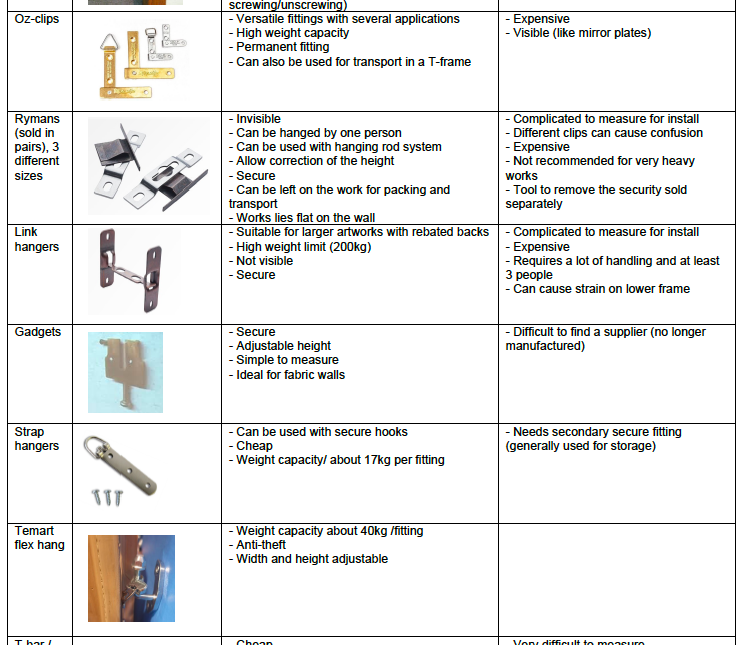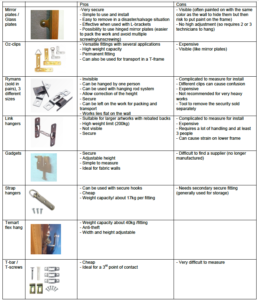
Hanging 101. Tim Crowley, Collections and Exhibition Technician, Ashmolean Museum
Tim Crowley started to work at the Ashmolean in 2009, when the museum was refurbished and opened a new extension. Tim has worked on numerous projects, including permanent galleries and temporary exhibitions such as Jeff Koons, Andy Warhol and Francis Bacon/Henry Moore.
Tim’s talk focused on the preparation of 2D works before they can go on display or on loan, and covered: the choice of glazing and backing, the best (or worse) display location within an exhibition space and the choice of hanging fittings.
Glazing and backing
Ideally, a work is glazed and backed, especially before going on display. The glazing acts as a physical barrier between a painting and the external environment and protects it against many threats such as dust or visitors’ fingers. It also offers climate regulation and in some cases, UV filtration.
Glazing can be acrylic (Perspex) or glass (often laminated low reflective glass).
It is important to identify the type of glass used on an artwork before packing it for a loan as some types of glazing will require taping while tape will damage others (LLRG for example).
The best way to tell the difference between Perspex and glass is the weight of the glazing. Glass will also be cooler to the touch. Laminated glass generally makes a dull sound when taped.
Perspex is generally used for larger works as it is much lighter. However, low reflective acrylic is generally more expensive than laminated low reflective glass.
Materials for backing can also vary: from soft fabric film, hardboard, twin wall polycarbonate, etc. A rigid baking is recommended as it will protect the work during the handling and reduce the risks of puncture. However, the backing can also add to the weight of the painting. Twin wall polycarbonate is a good option as it is light, transparent, rigid and includes a UV filter, but it is expensive (whereas hardboard is cheap).
Hanging fittings
Ideally, the fittings will be attached to the work before the works goes on loan and the work will be hung to the wall with at least 3 point of contact.
Many different types of fittings are used in museums and galleries to hang 2D works. All of them have their pros and cons and every institution or technician have their preferences.
During his talk, Tim detailed some of the hanging fittings used at the Ashmolean:
Tim insisted that, if the preparation of the artwork itself is key, it is also important to prepare the area where the artwork will be displayed.
Where NOT to hang an artwork.
Artworks should not be hung on external walls, above heat sources, in high traffic areas (risks of degradation), in direct sunlight or under picture lamps, in areas where food is prepared or consumed, on plasterboards thinner than 12mm, near heavy fire doors, lifts or IT services (vibrations) or near non-secured doors or windows for small works (theft).
When installing an artwork, we should also always be attentive to the environmental conditions (stable temperature and relative humidity within an appropriate range is required).
Wall structures
There is often a level of uncertainty in museums and galleries about the appropriate type of wall structures necessary to support an artwork.
The main materials used are plywood, plasterboard and MDF.
If you are not sure about the type of walls you have, a simple test is possible: put masking tape on a drill, drill into the wall up to the masking tape and the residue on the tape should indicate the type of structure: dust/powder = plasterboard; small hardwood fragments = plywood; softwood spirals = MDF; red/orange dust = brick; grey dust = concrete (avoid drilling in concrete walls if possible as it is very hard, dusty and messy and creates vibrations).
A screw should never continue to spin when installed. If this is the case, it shouldn’t be used to hang an artwork.
Screws are generally very strong and the weight capacity/strength should be detailed on the packaging. However, the solidity of the wall should be more of a concern than the solidity of the screws. A wall structure without wood won’t be as solid and it may need to be reinforced (by adding plywood for example) or more hanging fittings may be necessary to secure the work on the wall.
There is not ideal way to securely hang an artwork on a wall: the different options won’t be efficient, secure, aesthetic, easy to use and cheap at the same time. This is why it is important that the different options are discussed collectively with technicians, curators, conservators, registrars and lenders as early as possible in order to assess the risks and the resources and decide on the most appropriate solution.
Delphine Charpentier, Assistant Registrar (Loans), National Galleries of Scotland

 Instagram
Instagram  LinkedIn
LinkedIn  Twitter
Twitter  My Account
My Account 